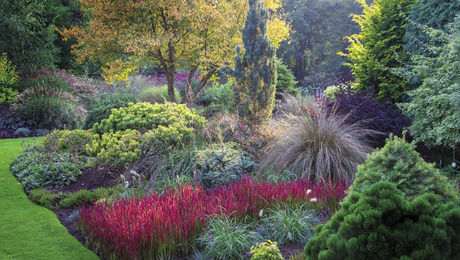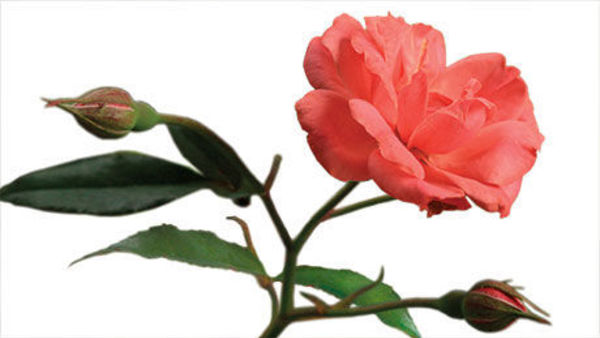
Most of us aren’t fortunate enough to have a full day’s worth of sun in our gardens, yet even the most experienced among us is still a little intimidated by shady areas. They’re often uncharted territory—the last place you want to plant because you’re not even sure what will grow there. But whether you have a shady entryway or a tree-shaded yard, there are plenty of options that can bring light and life to your dark space. Simply remember that a successful shade garden starts with good plant choices and adherence to the principles and elements of design.
When you begin exploring your plant options, you’ll discover a plethora of textures and forms. You’ll also find plenty of color—most notably, shades of green and light-simulating chartreuse and silver. The first step is to pair these plants, focusing on establishing contrast among textures, shapes, sizes, and colors to help you play up the qualities of each plant. Next, become aware of how the plant combinations work in relation to the scale of their environment, how they create focal interest, and how they draw the eye from one successful combination to the next. You’re striving to create individual combinations that add interest and fend off the monotony of hosta, hosta, hosta. But you’re also trying to create combos that contribute and connect to the overall landscape.
Here are examples of how picking the right plants and sticking to these basic elements of design can create a pleasing ensemble of plants that make the shade come alive.
Unite a Divided Space with Similar Plants

In this entry garden leading to the front door, the central stone path divides the garden in half, yet each side remains connected through repetition of the same or similar plants. For example, Japanese painted fern, ‘Aureola’ Japanese forest grass, ‘Nikko Blue’ hydrangea, Emperor I® Japanese maple, and ‘Blue Angel’ hosta are all duplicated on the opposite side of the path. The Japanese maples are essential for adding a little color and offering some transitional height between the canopy of mature oaks and the lower herbaceous perennials and small shrubs. The sun-loving pine in the foreground takes advantage of one of the few pockets of full sun and is right at home alongside its shady neighbors.
Light level: Partial shade
1. Japanese painted fern (Athyrium niponicum var. pictum, USDA Hardiness Zones 5–8)
2. ‘Patriot’ hosta (Hosta ‘Patriot’, Zones 3–9)
3. Angelonia (Angelonia angustifolia cv., annual)
4. ‘Nikko Blue’ hydrangea (Hydrangea macrophylla ‘Nikko Blue’, Zones 6–9)
5. ‘Frances Williams’ hosta (Hosta ‘Frances Williams’, Zones 3–9)
6. ‘Chidori Red’ ornamental kale (Brassica oleracea ‘Chidori Red’, annual)
7. ‘Aureola’ Japanese forest grass (Hakonechloa macra ‘Aureola’, Zones 5–9)
8. ‘Blue Angel’ hosta (Hosta ‘Blue Angel’, Zones 3–9)
9. Emperor I® Japanese maple (Acer palmatum* ‘Wolff’, Zones 5–8)
10. ‘Chalet’ Swiss stone pine (Pinus cembra ‘Chalet’, Zones 3–7)
A Little Color Goes a Long Way

What’s the first thing that comes to mind when you think of a shade garden? Probably not color. When color is used, however, a little bit can make an impact. In this combination, ‘Red Ruffles’ coleus adds a splash of rich color that ties the combo to the warm, reddish tones of the stone path and a burgundy Japanese maple in the background. The large variegated leaves of ‘Frances Williams’ hosta create a focal point and complement the deep color of the coleus and the fine-textured foliage of ‘Aureola’ Japanese forest grass. Although hostas like this are often seen going solo in a shade garden, they look best when paired with other plants.
Light level: Partial shade
1. ‘Red Ruffles’ coleus (Solenostemon scutellarioides ‘Red Ruffles’, Zone 11)
2. ‘Frances Williams’ hosta (Hosta ‘Frances Williams’, Zones 3–9)
3. ‘Aureola’ Japanese forest grass (Hakonechloa macra ‘Aureola’, Zones 5–9)
Even in Shade, Scale is Important

Large groups of herbaceous perennials provide impact and appropriate scale near the foundation of this home. Layering bands of contrasting textures, shapes, heights, and colors add depth, interest, and drama. The bright chartreuse foliage of the fine-textured Japanese forest grass highlights the edge of the bed while drawing the viewer’s eye to other foundation plants. The group of tall ‘Lavender Mist’ meadow rues offers height and transparency without compromising the view from the window behind them. Several pines to the left of this combo offer year-round stability as the flowers of hydrangea, ligularia, and meadow rue come and go throughout the seasons.
Light level: Partial shade
1. ‘Aureola’ Japanese forest grass (Hakonechloa macra ‘Aureola’, Zones 5–9)
2. ‘Blue Angel’ hosta (Hosta ‘Blue Angel’, Zones 3–9)
3. ‘Nikko Blue’ hydrangea (Hydrangea macrophylla ‘Nikko Blue’, Zones 6–9)
4. Angelonia (Angelonia angustifolia cv., annual)
5. ‘The Rocket’ ligularia (Ligularia stenocephala ‘The Rocket’, Zones 4–8)
6. ‘Lavender Mist’ meadow rue (Thalictrum rochebruneanum ‘Lavender Mist’, Zones 5–9)
Go Short in the Middle

Sometimes it’s all right to break the rules: Short plants don’t have to be used only at the garden’s edge. This river of heuchera flows between taller plants, directing the eye to various points of interest in this deep border. The color of the heuchera relates to the Japanese maple’s canopy of foliage but, more important, creates depth and separation among the other plants. Just the right amount of variegated and chartreuse foliage adds further interest to this otherwise dark grouping. Three hosta varieties are separated by contrasting plant textures and leaf colors, making each one special while also complementing their bedmates.
Light level: Full to partial shade
1. ‘Frances Williams’ hosta (Hosta ‘Frances Williams’, Zones 3–9)
2. ‘Obsidian’ heuchera (Heuchera ‘Obsidian’, Zones 3–8)
3. ‘Blue Angel’ hosta (Hosta ‘Blue Angel’, Zones 3–9)
4. Emperor I® Japanese maple (Acer palmatum* ‘Wolff’, Zones 5–8)
5. ‘Aureola’ Japanese forest grass (Hakonechloa macra ‘Aureola’, Zones 5–9)
6. ‘Patriot’ hosta (Hosta ‘Patriot’, Zones 3–9)
7. Japanese painted fern (Athyrium niponicum var. pictum, Zones 5–8)
Take Extra Care Under Big Trees

Large masses of perennials are necessary in this part of the shade garden to compete with the massive oaks that dominate the scene. Big trees, however, are the bullies of the shade-garden playground. They are the first in line to take the majority of water and nutrients, leaving little for the plants beneath them. Curb the effects of these bullies’ bad habits by taking extra care to provide adequate water, fertility, and organic matter to your shade plants. With a little special attention, this part of the garden holds up and blends right in with the rest of the landscape. Drifts of white impatiens add a helping hand with a dash of flower power that connects the garden areas on either side of the grass path.
Light level: Full to partial shade
1. ‘Northern Pride’ Siberian cypress (Microbiota decussata ‘Northern Pride’, Zones 3–7)
2. ‘Love Pat’ hosta (Hosta ‘Love Pat’, Zones 3–9)
3. Bur oak (Quercus macrocarpa, Zones 3–9)
4. ‘Obsidian’ heuchera (Heuchera ‘Obsidian’, Zones 3–8)
5. ‘Sum and Substance’ hosta (Hosta ‘Sum and Substance’, Zones 3–9)
6. Accent® White impatiens (Impatiens walleriana Accent® White, annual)
Use Annuals to Fill in the Gaps

Annuals in a border not only boost the scene with continuous color but also help fill in gaps when perennial plantings aren’t mature enough to do the work on their own. The impatiens in this combo is an easy annual to grow in shade, but also consider begonias (Begonia spp. and cvs., Zones 8–11), torenia (Torenia spp. and cvs., Zones 10–11), and foliage favorites such as coleus (Solenostemon scutellarioides cvs., Zone 11), hypoestes (Hypoestes spp. and cvs., Zones 10–11), and tradescantia (Tradescantia spp. and cvs., Zones 8–11)—all treated as annuals in Minnesota but as perennials in other regions. Add even more interest with details like the beautiful bark of threeflower maple.
Light level: Full shade
1. ‘Aureola’ Japanese forest grass (Hakonechloa macra ‘Aureola’, Zones 5–9)
2. ‘Jack Frost’ brunnera (Brunnera macrophylla ‘Jack Frost’, Zones 3–7)
3. Accent® White impatiens (Impatiens walleriana Accent® White, annual)
4. ‘Frances Williams’ hosta (Hosta ‘Frances Williams’, Zones 3–9)
5. Korean wax bells (Kirengeshoma palmata, Zones 5–8)
6. Threeflower maple (Acer triflorum, Zones 5–7)
—Scott Endres is co-owner of Tangletown Gardens in Minneapolis, Minnesota.
What’s My Shade?There are more shade-plant options these days than ever before, but you still have to pick those that work within the light levels prevalent in your garden. How do you do this? Monitor the hours of sunlight to successfully pair the right plants to your location. Some areas will likely get more light than others, and you may surprise yourself by finding that there are pockets of full sun and partial shade in your shade garden. Be honest with yourself when assessing your light levels. It is easy to make ourselves believe that we get that extra hour or two of sun to justify adding a sexy new plant to the garden. Even if the plant survives, it will not thrive if it doesn’t receive its minimum light requirements—not very sexy. Full Shade: Site receives less than three hours of sun per day. Partial shade: Site receives three to five hours of sun per day. Full Sun: Site receives more than five hours of sun per day. |
Photos: Brandi Spade
Fine Gardening Recommended Products

A.M. Leonard Deluxe Soil Knife & Leather Sheath Combo
Fine Gardening receives a commission for items purchased through links on this site, including Amazon Associates and other affiliate advertising programs.



















Comments
Log in or create an account to post a comment.
Sign up Log in